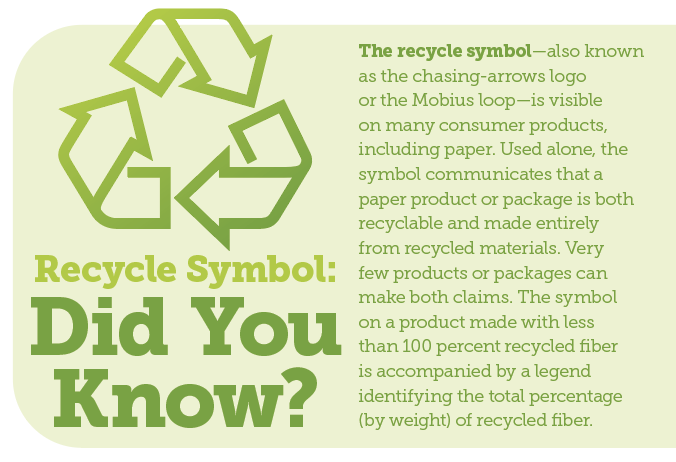C onsumers these days are continually encouraged to “go paperless” in order to “go green” based on outdated notions that paper is wasteful and that ink is made from petroleum products.
The truth is that commercial printing and paper manufacturing is, in fact, a leading industry in sustainability. When choosing print, brands can actually create eco-friendly experiences for their customers, and they should not shy away from telling those stories. From printing on recycled paper to using soy-based inks and paper manufactured from certified sustainably managed forests, print has “greened up” in many ways, making it an eco-friendly choice for communications and marketing collateral.
Big Opportunities for Brands
“In recent years, climate has pushed sustainability to the forefront of business media, boardroom, and C-suite consciousness,” Chris McLaren, CMO of the Forest Stewardship Council US (FSC) says in the FSC’s June 2021 newsletter. “Many corporate leaders realize that future economic success will depend significantly on actions taken today. While some of this change can be attributed to changing consumer desires, businesses are reacting perhaps even more to demand from their other stakeholders.”
To this end, greening internal operations for print organizations and paper mills is a cornerstone of any corporate social responsibility (CSR) program, and companies such as Walmart and REI are working with FSC-certified materials and/or have adopted the criteria for sourcing print materials throughout their supply chains from certified print vendors.
”In 2021, customers judge every aspect of the brands they buy from, particularly the brands they’re loyal to. These shoppers expect companies to be thinking about everything, including the impact they’re having on the planet.
Madison FioreHead of Growth at Hawke Media

It is not just Fortune 500 companies driving the demand for greener printing. Many midsized businesses and start-ups want to position themselves as green, and marketing firms that cater to these clients have taken note. “In 2021, customers judge every aspect of the brands they buy from, particularly the brands they’re loyal to,” says Madison Fiore, Head of Growth at Hawke Media. “From the way the products are manufactured to how they treat their employees and even their packaging.”
“These shoppers expect companies to be thinking about everything, including the impact they’re having on the planet,” says Fiore. He reports that many of Hawke Media’s top clients use green packaging and sustainable manufacturing practices. In fact, today it is not uncommon for sustainability requirements to be built directly into print and packaging RFPs—another sign of the times and the desire to work with print organizations that are following best practices when it comes to sustainability, corporate responsibility, recycling, and green initiatives.
Paper Goes Green
What sustainability practices can marketers and designers look for when specifying paper and print? Here are a few nuggets to consider:
Recycled Paper
Knowledge, application, and use of recycled papers are a great place to start, but not all recycled papers are created equal. We assume recycled means composed of reused paper, but the percentages of recycled fiber versus virgin fiber can vary, and how the recycled fibers are processed can be different.
There are two types of recycled fiber used to make recycled paper: post-consumer reclaimed material and pre-consumer reclaimed material. The two are fundamentally different, as the FSC specifies in its definitions. Post-consumer reclaimed material is reclaimed from a consumer or commercial product that has been used for its intended purpose by individuals, households, or commercial, industrial, or institutional facilities in their role as end users of the product.
Post-consumer recycled paper embodies the circular economy. It is manufactured from recycled products that have served a purpose for end users, and it is then recycled again.
Pre-consumer fiber, also known as postindustrial fiber, is recovered from paper used in industrial applications such as print makereadies, bindery paper trimmings, or newsstand magazine returns that never sold and, therefore, never reach or are used by end users. As such, it is not a full-fledged member of the circular economy because the paper never serves a useful purpose in the consumer marketplace before it is recycled.
FSC-Certified Papers and Print Organizations
Another option is choosing FSC-certified paper and working with an FSC-certified print organization. The FSC uses a system of tracking paper and pulp through the entire supply-chain process. The FSC system provides an assurance that trees have been harvested for paper and pulp in a socially and environmentally responsible manner. Although FSC-certified paper often contains recycled paper, it does not have to contain it to be certified.
NEW! Carbon-Balanced Paper
Carbon-balanced paper came on to the market in April 2021. Carbon-balanced means that the average carbon dioxide impact created during the entire paper production process, including delivery, has been offset to create a net-zero impact on climate change.
Water and Soy-Based Inks and Coatings
Water-based inks and coatings and soy-based inks are gentle on the environment while still producing clear, vibrant images. Both work well on uncoated and coated paper stocks. Ink is made up of pigment (which gives it color), additives (which allow drying and eliminate smudging), and carriers (which allow the ink to adhere to the paper). Water and soy-based inks rely on natural materials instead of petroleum as the carrier. In addition to being better for the planet, these inks are healthier for print-facility employees due to their lack of noxious emissions.
The print industry has come a long way toward sustainability since the days of petroleum-based inks and paper made from logging unmanaged virgin forests. As McLaren notes, “Some of the US’s biggest brands (e.g., Amazon and Microsoft) are not only changing their own practices, but also working pre-competitively to incentivize, inform and enable change across their entire industries.” Kudos to the print industry for doing the same.
Indeed, when you choose to print your marketing collateral, direct mail, or other projects, you can make environmentally sound decisions that encourage sustainability and support a circular economy.
It’s one thing to talk like an environmental steward, it’s another thing to be one.
- Forestry Stewardship Council® (FSC®) Chain-of-Custody Certification
- SGP-Certified Print Facility
- Production materials recycled/reused
- 952 Tons of recycled waste in 2020
- 10,400 Pounds of waste saved via organics programs
- Zero Hazardous/toxic chemicals used
- Zero Landfill production facility
Ask about Bolger’s corporate responsibility initiatives and how your print can be part of a sustainability success story.







